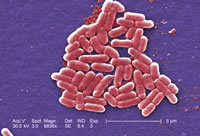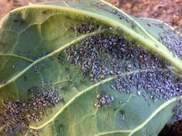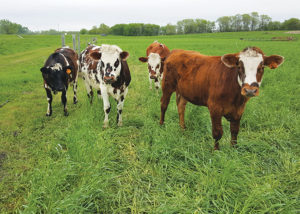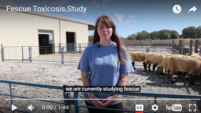|
|
|
Fresh from the Field is a weekly album showcasing transformative impacts made by grantees supported by the National Institute of Food and Agriculture.
Feb. 23, 2017
|
|
Success Stories of the Week
 A bright idea to detect bacteria in foods
Escherichia coli (E. coli) O157:H7 is a toxin-producing
bacteria that poses a major threat to human health through food contamination.
Scientists at Purdue University may soon have a new way to detect E. coli in
food with glow-in-the-dark-bacteria.
Supported by NIFA funding, Purdue
University researchers have engineered a virus called NanoLuc that infects
and lights up this particular strain of E. coli. The process may shave
hours off traditional testing methods, a critical need in preventing the
distribution of tainted foods.
Read the Purdue University story here.
|
 Organic pesticides help manage cabbage aphids
Severe infestations of cabbage aphids can destroy a crop of Brussels sprouts, making them unmarketable. With NIFA funding, scientists from the
University of New Hampshire discovered that organic pesticides can be effective
in managing the pests.
Researchers compared two different methods of managing
cabbage aphids: intercropping with flowers that host aphid predators, and using
organic insecticides. They learned that weekly scouting and organic pesticide
application were useful in controlling cabbage aphids.
Read the UNH article here.
|
 Making organic farms more resilient
Researchers at Iowa
State University, the University of Minnesota, and Rodale Institute are evaluating the production, environmental,
and economic benefits of growing cash crops in rotation with forage crops used
for grazing. This project is supported by NIFA’s Organic Research and Extension
Initiative (OREI).
The researchers note that organic production in the United States is dominated by cash grain crops, with the majority of organic farmers in the Midwest and Northeast using off-farm purchases to feed their organic animal herds. The research investigates the benefits of integrating livestock into organic cropping systems
Read more at the Midwest Organic and Sustainable
Education Service site.
|
 Feeding candy to cattle helps producers save cash
News circulated earlier this year about a truck hauling Skittles® candy to a producer in Wisconsin, where it was to be mixed into feed for cattle.
“For cattle, other than a taste difference, candy is not
any different than corn in the diet. It may serve as an energy source for the cattle,”
said Chris Richards, Oklahoma State University Cooperative Extension beef
cattle nutrition specialist. “The bacteria in the rumen of the cattle break
down the candy into the same materials it would the starch in the corn they are
fed.”
Read the High Plains/Midwest Ag Journal article here.
|
New farm-based research guide now available
A new educational resource is available from Sustainable Agriculture Research Education (SARE), a NIFA-funded organization, which offers grants and education to foster sustainable agriculture, productivity, profitability, environmental stewardship, and quality of life. This new technical bulletin from SARE’s Ag Innovations Series provides detailed instruction for crop and livestock producers, as well as educators, on how to conduct farm- or ranch-based research using practical strategies and peer-reviewed research findings.
Read the new SARE bulletin here.
 Grass fungus may cause $1 billion in annual livestock
production losses
Clemson University scientists are researching a grass fungus
that may cause $1 billion in annual livestock production losses. The research
is supported through NIFA’s Agriculture and Food Research Initiative (AFRI)
program. Tall fescue is a hardy, drought-tolerant perennial grass that is
commonly used for grazing, hay, and erosion control in the eastern United
States. Scientists are investigating a fungus in the plant that creates
compounds which are beneficial to the plants, but toxic to livestock.
Watch the video.
|
#NIFAIMPACTS
|
|
|
For more NIFA impacts,
visit nifa.usda.gov/impacts or
the Land-Grant University Impacts website. Send us your NIFA-funded impacts at impactstories@nifa.usda.gov or share them with
USDA_NIFA on Twitter
#NIFAimpacts.
NIFA invests in and advances agricultural research, education, and extension and seeks to make transformative discoveries that solve societal challenges.
Editor: Falita Liles; Co-Editor: Carlos Harris
|
|